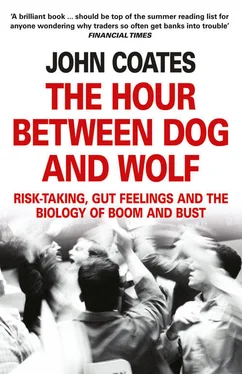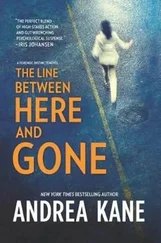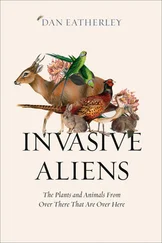It should come as no surprise that athletes facing fast-moving objects like cricket balls or ice hockey pucks frequently fail to intercept them (or in boxing to avoid them). But if an athlete succeeds, say, one time out of three, as a good baseball player does when at bat, his success rate approaches that of many predators in the wild. A lion, for example, closing in on an antelope, or a wolf on a deer, catches its prey on average one time out of three. In sport, as in nature, competition has pushed reaction times right to the frontier of the biologically possible.
Unfortunately, those of us not gifted with the reaction times of an Olympic athlete are nonetheless often called upon to respond with something like their speed, especially while on the road. A driver speeding at 70 miles an hour has as little as 370 milliseconds to avoid a car 75 feet in front that has mistakenly swerved into the oncoming lane. Here a success rate of one out of three still leaves a lot of car crashes.
The speed demanded of our physical reactions, in the wild, in sports, on the road, even in the financial markets, raises troubling questions when lined up against certain findings in neuroscience. Take this curious fact, for instance: once an image hits the retina, it takes approximately 100 milliseconds – that is a full tenth of a second – before it consciously registers in the brain. Pause for a moment and contemplate that fact. You will soon find it profoundly disturbing. We tend to think, as we survey the world around us or sit in the stands of a sporting match, that we are watching a live event. But it turns out that we are not – we are watching news footage. By the time we see something, the world has already moved on.
The trouble stems from the fact that our visual system is surprisingly slow. When light hits our retina, the photons must be translated into a chemical signal, and then into an electrical signal that can be carried along nerve fibres. The electrical signal must then travel to the very back of the brain, to an area called the visual cortex, and then project forward again, along two separate pathways, one processing the identity of the objects we see, the ‘what’ stream, as some researchers call it, and the other processing the location and motion of the objects, the ‘where’ stream. These streams must then combine to form a unified image, and only then does this image emerge into conscious awareness. The whole process is a surprisingly slow one, taking, as mentioned, up to one tenth of a second. Such a delay, though brief, leaves us constantly one step behind events.
Neuroscientists have discovered another problem with the idea that we are watching the world live. An important part of this idea is the notion that our eyes objectively and continuously record the scene before us, much like a movie camera. But eyes do not operate like this. If we continuously recorded the visual information presented to us, we would waste a great deal of time (and probably suffer constant headaches) looking at blurred images as our eyes pan from one scene to another. More importantly, we would be swamped by the sheer amount of data, most of which is irrelevant to our needs. Live streaming takes up an enormous amount of bandwidth on the internet, and it does so as well in our brains. To avoid a needless drain on our attentional resources, our brain has hit upon the tactic of sampling from a visual scene, rather than filming it. Our eyes fix on a small section of our visual field, take a snapshot, then jump to another spot, take a snapshot, and quickly jump again, much like a hummingbird nervously flitting from flower to flower. We are largely unaware of this process, and do not see a blur when our eyes shift location because, remarkably, the visual system stops sending images up to consciousness while it jumps from scene to scene. Furthermore, we are unaware of these jumps and intervening blackouts because our brain weaves these images seamlessly into something that does appear much like a movie. We can perform up to five of these visual jumps per second, the minimum amount of time required for a shift in view being therefore one fifth of a second.
If we return to sports, we can see that some numbers do not add up. How can a cricketer at silly point catch (or duck) a ball in under a tenth of a second if he is not even aware of it yet? How can he direct his attention to the ball if it takes him twice as long just to move his eyes? And when dealing with these numbers we have not even begun to consider the additional 300–400 milliseconds required for an elementary cognitive decision or inference, and the 50 milliseconds or so it takes for a motor command to be communicated by nerves to our muscles. The picture conjured by these numbers is one of an infielder frozen in the readiness stance, eyes fixed like a waxwork model, while a projectile shudders past his immobile and fragile head.
The same questions we ask about athletes can be asked, and with more urgency, beyond the cricket pitch. How can we humans survive in a brutal and fast-moving world if our consciousness arrives on the scene just after an event is over? This is a baffling question. But asking it allows us to see what is wrong with the notion of the brain as a central processor, taking in objective information from the senses in the manner of a camera, processing this information rationally, consciously and discursively, deciding on the appropriate and desired action, and then issuing motor commands to our muscles, be they larynx or quadriceps. Each of these steps takes time, and if we were indeed programmed to behave this way, then life as we know it would be very different. If we had to think consciously about every action we took, sporting events would become odd, slow-motion spectacles that few people would have the patience to watch. Worse, in nature and in war we would have long ago fallen prey to some quicker beast.
I, CAMERA?
It turns out that there is something wrong with each step in this supposed chain of mental events. The eye takes snapshots rather than movies; but even these snapshots are not a photographic and objective record of the outside world. All sensory information comes to us tampered with. Like the news on TV, it is filtered, warped and pre-interpreted in a way designed to catch our attention, ease comprehension and speed our reactions.
Take for instance the ways in which the brain deals with the problem of the one-tenth-of-a-second delay between viewing a moving object and becoming consciously aware of it. Such a delay puts us in constant danger, so the brain’s visual circuits have devised an ingenious way of helping us. The brain anticipates the actual location of the object, and moves the visual image we end up seeing to this hypothetical new location. In other words, your visual system fast-forwards what you see.
An extraordinary idea, but how on earth could we ever prove it to be true? Neuroscientists are devilishly clever at tricking the brain into revealing its secrets, and in this case they have recorded the visual fast-forwarding by means of an experiment investigating what is called the ‘flash-lag effect’. In this experiment a person is shown an object, say a blue circle, with another circle inside it, a yellow one. The small yellow circle flashes on and off, so what you see is a blue circle with a yellow circle blinking inside it. Then the blue circle with the yellow one inside starts moving around your computer screen. What you should see is a moving blue circle with a blinking yellow one inside it. But you do not. Instead you see a blue circle moving around the screen with a blinking yellow circle trailing about a quarter of an inch behind it. What is going on is this: while the blue circle is moving, your brain advances the image to its anticipated actual location, given the one-tenth-of-a-second time lag between viewing it and being aware of it. But the yellow circle, blinking on and off, cannot be anticipated, so it is not advanced. It thus appears to be left behind by the fast-forwarded blue circle.
Читать дальше











![John Bruce - The Lettsomian Lectures on Diseases and Disorders of the Heart and Arteries in Middle and Advanced Life [1900-1901]](/books/749387/john-bruce-the-lettsomian-lectures-on-diseases-and-disorders-of-the-heart-and-arteries-in-middle-and-advanced-life-1900-1901-thumb.webp)
